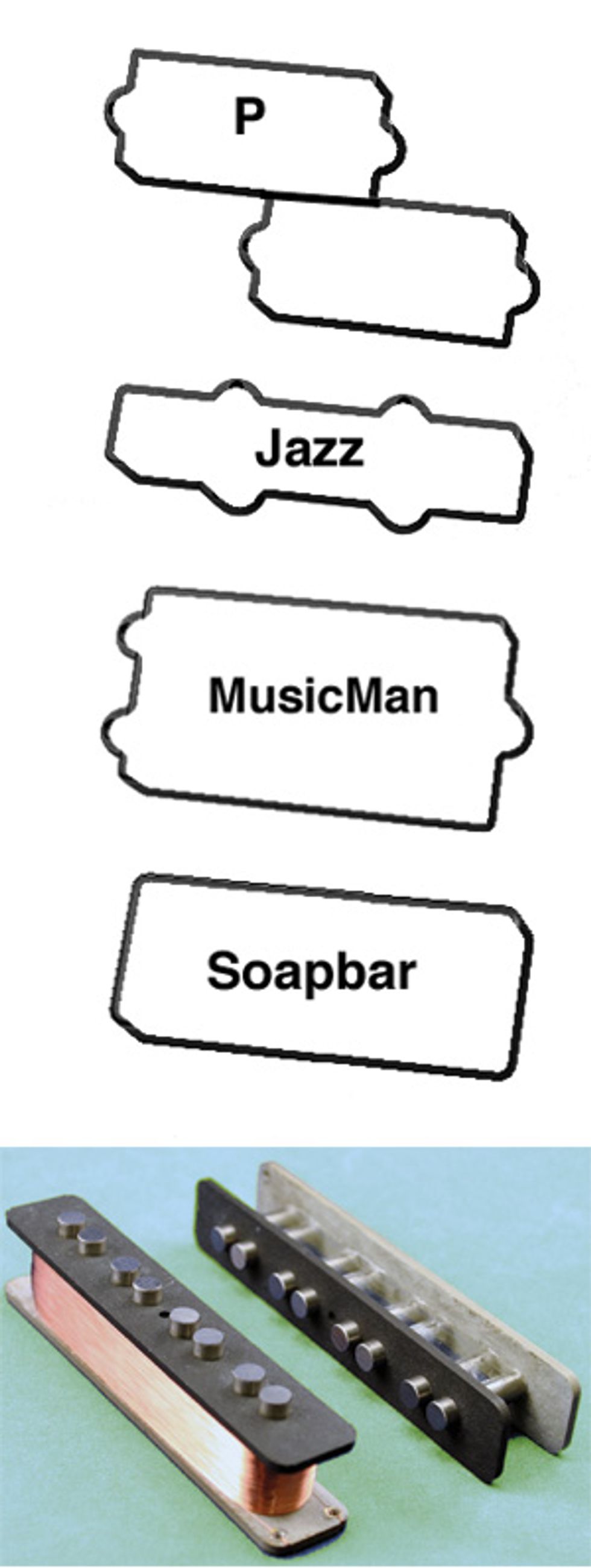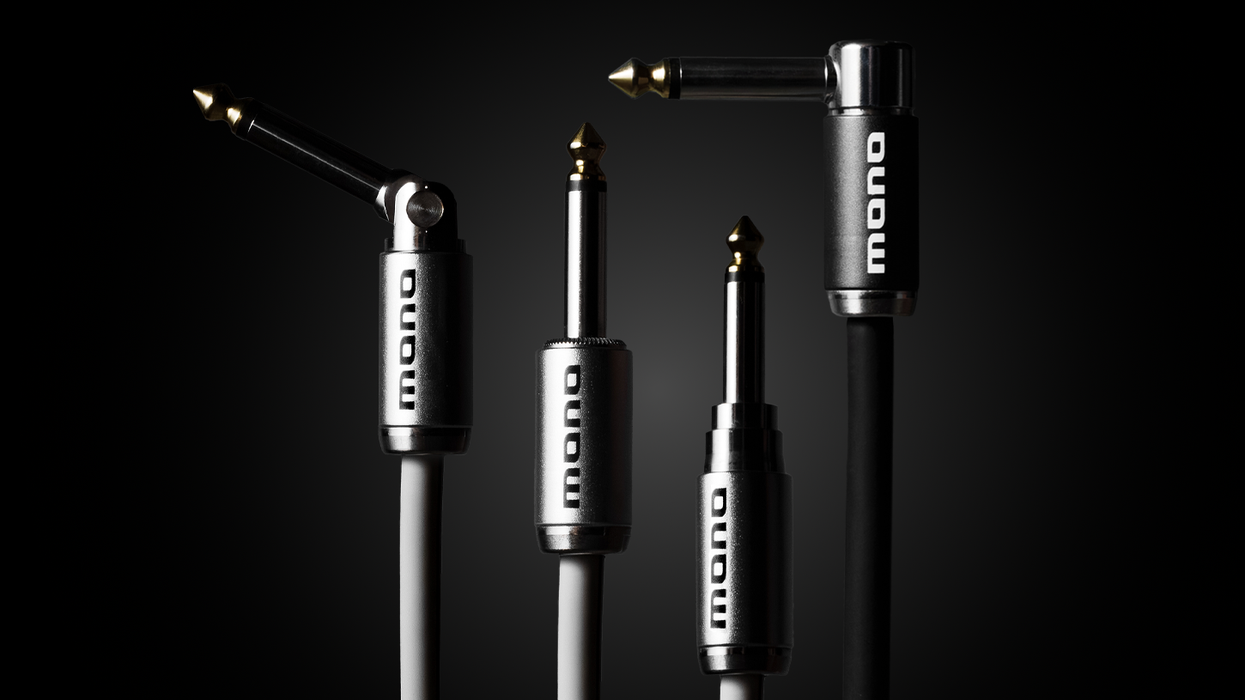
Fig. 1 The most popular bass pickup shapes in historical order from older (top) to newer designs. Fig. 2 A single-coil pickup with magnets, bobbin, and final wiring.
So far in the short history of this column, we’ve discussed several ways to manipulate bass tone, yet carefully avoided naming or identifying the origin of this electric current—the pickup. A pickup converts the mechanical movement of our strings into an electric signal that we can modify and amplify. But how do we translate string movement into an electrical signal? Several ways to do this come to mind:
Piezo. In 1880, French brothers Jacques and Pierre Curie discovered the piezoelectric effect. Putting mechanical pressure on certain types of non-conductive crystals leads to a directly proportional, microscopic voltage.
Optical. Direct a source of light towards a moving string and use a photodiode—a semiconductor that converts light to an electric current—to sense these alternating moments of shade and light. The changes in the sensor give us a direct electric picture of what the string does. Ron Hoag displayed the first pickup of this kind at the 1969 summer NAMM show in Chicago.
Electromagnetic. A permanent magnet emits a magnetic flux. Moving a ferrous material in this field alters the magnetic flux, inducing a voltage in a wire that’s wound around the magnet. While piezo pickups and optical sensors work with all string materials, the electromagnetic pickup is limited to ferrous ones. No problem here, as we typically use steel strings.
Technically, these pickups are all called transducers, as they convert one form of energy (mechanical movement) into another (electric current or voltage). I can’t think of any more ways to convert a string’s physical movement into voltage. (If you know of other ways, either contact me or head directly to your patent office. Don’t mention microphones, as they are simply an electromagnetic transducer that uses more parts. And we won’t count condenser mics either.)
Let’s look more closely at these three types of converters, starting with the one we all think we know best, the electromagnetic pickup. Our bass pickups come in several shapes and sizes. You can see the most popular profiles in Fig. 1. The Precision and Jazz pickups started as single-coils, while the Music Man and soapbar pickups initially came as humbuckers. Today, with the huge replacement parts industry, you can’t judge the number of coils simply by shape: There are humbucking P and J pickups, as well as single-coil soapbars. Another thing you can’t see—at least as long as the battery cable is hidden—is whether a pickup is active or passive.
Due to their construction, humbuckers and single-coils can be classed as different types of pickups and both are known for certain tones—although the lines between these sounds are not that strict. Since the market offers thousands of magnetic pickups, there must be something else that sets them apart. The basic construction is very simple and their only parts are a permanent magnet and a coil surrounding said magnet. Add something that holds everything in place and voilà—you have a pickup (Fig. 2).
So what else can differentiate pickup models? Really it comes down to the material, number, arrangement, shape, and size of the permanent magnet(s) and the material, diameter, and number of turns of the wire that forms the coil.
Do these variables justify the existence of thousands of pickup models? While preparing to write this month’s column, I dug much deeper into this subject than I’d initially intended, and ended up re-reading a few hundred pages on electrodynamics and magnetism. This is an extremely interesting area of physics, but did it help me better understand pickups? Yes, but not as one would think.
The magnetic pickup is surrounded by a cult—a land of mystical promises and nebulous PR. Add the word vintage and it gets even stranger—and way more expensive. We deal with voltage and current all the time, from the 12V power in cars to the 110V or 220V outlets in our homes. We’ve all dealt with electric shocks, so we know its there, but we rarely see or feel the power or reactions of magnetic forces. The physics can be extremely complex, and those who really understand these forces rarely end up winding pickups. Hence, marketing guys can tell us almost anything.
There are no tricks for making the perfect pickup. The Holy Grail doesn’t exist and every advantage has its drawbacks. Does it help to swap pickups? Yes, sometimes. But why begin with the most expensive component on your instrument? It makes more sense to start with the surrounding elements and investigate pot load, cable quality, and circuitry.
You might want to re-read “Maxwell’s Silver Hammer of the Gods”—the March 2012 PG column by Gregg Stock about passive pickups. As bassists, simply ignore the word “guitar”—the physics behind bass pickups is the same—and try to understand some of the interdependent factors Stock describes.
In the end, you can just stay with what you have, or fall for the advertising, or start to experiment and educate yourself. If you’re interested in the latter, stay tuned because we’ll be looking at a few guidelines in upcoming columns.
 Heiko Hoepfinger is a German
physicist and long-time bassist, classical
guitarist, and motorcycle enthusiast. His
work on fuel cells for the European orbital
glider Hermes got him deeply into modern
materials and physical acoustics, and
led him to form BassLab (basslab.de)—a
manufacturer of monocoque guitars and basses. You can
reach him at
chefchen@basslab.de..
Heiko Hoepfinger is a German
physicist and long-time bassist, classical
guitarist, and motorcycle enthusiast. His
work on fuel cells for the European orbital
glider Hermes got him deeply into modern
materials and physical acoustics, and
led him to form BassLab (basslab.de)—a
manufacturer of monocoque guitars and basses. You can
reach him at
chefchen@basslab.de..




![Rig Rundown: AFI [2025]](https://www.premierguitar.com/media-library/youtube.jpg?id=62064741&width=1245&height=700&quality=70&coordinates=0%2C0%2C0%2C0)












 Shop Scott's Rig
Shop Scott's Rig















































